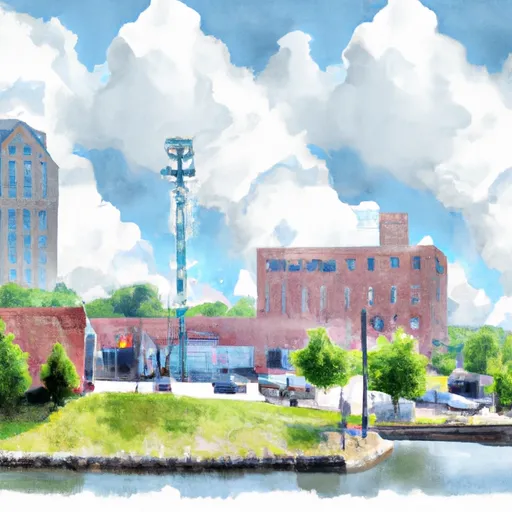-
 Snoflo Premium
Snoflo Premium
Get unlimited access to all our content
With no Ad interruptions! - Start Your Free Trial Login with existing account
New-Baltimore
Eden Index
Climate
9.2
•
Recreation
2.8
•
Community
4.2
•
Safeguard
5.7/10

Located in Macomb County, Michigan, New Baltimore is a charming small town situated along the beautiful Anchor Bay. It experiences a humid continental climate, characterized by warm summers and cold winters. Summers are typically mild with temperatures ranging from the 70s to 80s Fahrenheit, while winters can be harsh with temperatures dropping to the 20s and 30s. Precipitation is well-distributed throughout the year, with snowfall occurring during the winter months.
New Baltimore benefits from its proximity to Anchor Bay, part of Lake St. Clair. This hydrological feature offers residents and visitors a variety of outdoor recreation opportunities. Boating, fishing, and swimming are popular activities during the warmer months, while ice fishing and ice skating are enjoyed in the winter. The bay's calm waters also provide an ideal environment for kayaking and paddleboarding.
Additionally, the town boasts several parks, including Walter and Mary Burke Park, which offers picnic areas, playgrounds, and a beach. Outdoor enthusiasts can explore the Anchor Bay Trail, a multi-use trail that winds along the waterfront and provides scenic views. With its favorable climate and abundant water resources, New Baltimore is an appealing destination for nature lovers and outdoor enthusiasts.
What is the Eden Index?
The Snoflo Eden Index serves as a comprehensive rating system for regions, evaluating their desirability through a holistic assessment of climate health, outdoor recreation opportunities, and natural disaster risk, acknowledging the profound impact of these factors on livability and well-being.
Climate Health Indicator (CHI): 9.2
New-Baltimore receives approximately
854mm of rain per year,
with humidity levels near 77%
and air temperatures averaging around
10°C.
New-Baltimore has a plant hardyness factor of
6, meaning
plants and agriculture in this region thrive during a short period during spring and early summer. Most
plants will die off during the colder winter months.
By considering the ideal temperature range, reliable water supplies, clean air, and stable seasonal rain or snowpacks, the Climate Health Indicator (CHI) underscores the significance of a healthy climate as the foundation for quality living.
A healthy climate is paramount for ensuring a high quality of life and livability in a region, fostering both physical well-being and environmental harmony. This can be characterized by ideal temperatures, reliable access to water supplies, clean air, and consistent seasonal rain or snowpacks.
Weather Forecast
Streamflow Conditions
St. Clair-Detroit
Area Rivers
St. Clair-Detroit
Snowpack Depths
St. Clair-Detroit
Reservoir Storage Capacity
St. Clair-Detroit
Groundwater Levels
Recreational Opportunity Index (ROI): 2.8
The Recreational Opportunity Index (ROI) recognizes the value of outdoor recreational options, such as parks, hiking trails, camping sites, and fishing spots, while acknowledging that climate plays a pivotal role in ensuring the comfort and consistency of these experiences.
Access to outdoor recreational opportunities, encompassing activities such as parks, hiking, camping, and fishing, is crucial for overall well-being, and the climate plays a pivotal role in enabling and enhancing these experiences, ensuring that individuals can engage in nature-based activities comfortably and consistently.
Camping Areas
| Campground | Campsites | Reservations | Toilets | Showers | Elevation |
|---|---|---|---|---|---|
| North Park | 180 | 606 ft | |||
| Holiday Beach Conservation Area | None | 578 ft | |||
| Wagener County Park | 96 | 593 ft | |||
| Stafford County Park | 73 | 587 ft | |||
| Lighthouse County Park | 110 | 598 ft |
Nearby Fishing
Nearby Ski Areas
Catastrophe Safeguard Index (CSI):
The Catastrophe Safeguard Index (CSI) recognizes that natural disaster risk, encompassing floods, fires, hurricanes, and tornadoes, can drastically affect safety and the overall appeal of an area.
The level of natural disaster risk in a region significantly affects safety and the overall livability, with climate change amplifying these risks by potentially increasing the frequency and intensity of events like floods, fires, hurricanes, and tornadoes, thereby posing substantial challenges to community resilience and well-being.
Community Resilience Indicator (CRI): 4.2
The Community Resilience Indicator (CRI) recognizes that education, healthcare, and socioeconomics are crucial to the well-being of a region. The CRI acknowledges the profound impact of these elements on residents' overall quality of life. By evaluating educational resources, healthcare accessibility, and economic inclusivity, the index captures the essential aspects that contribute to a thriving community, fostering resident satisfaction, equity, and social cohesion.

